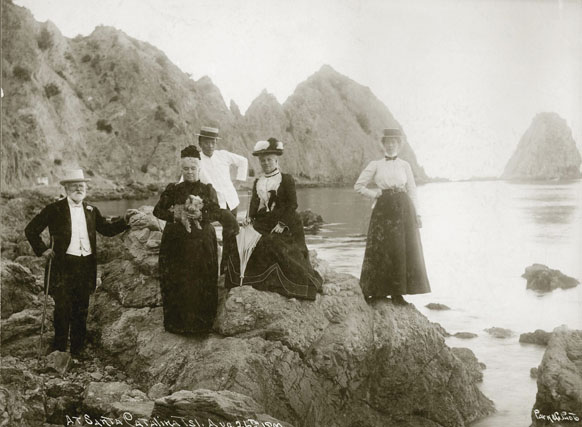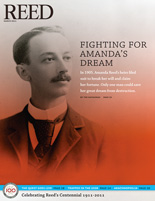
IRIS login | Reed College home Volume 90, No. 1: March 2011
Fighting for Amanda's Dream (continued)

Beside the seaside: Amanda Reed with companions (human and canine) on Catalina Island, California, in 1900.
Without Winch to advocate for a vocational school, the outcome was predictable. Buttrick recommended a liberal arts school, and the board voted to accept his recommendation. Eliot traveled to Hood River to break the news.
Outmaneuvered, Winch reluctantly agreed to back the plan, accepting a compromise that left open the possibility of adding industrial training to the curriculum in the future. “PORTLAND IS TO HAVE BIG COLLEGE—Trade School Idea Is Dropped” the Oregonian declared.
Winch and Eliot dueled again over the school’s location. Winch favored a practical close-in tract in what is now Laurelhurst. Eliot preferred Crystal Springs, a 40-acre cow pasture in Sellwood, which in that day seemed far from the bustle of the city, offered as a gift by the Ladd family.
In February 1910, Winch, now recuperating at a hotel in Los Angeles, heard that the board had chosen Crystal Springs, and fired off an exasperated telegram:
protest against the selection of crystal springs site the city is growing north not south
Two days later, Winch wrote a letter to Eliot reiterating his objections and complaining that the trustees were ignoring Amanda’s wishes. Eliot responded with a conciliatory letter: “it seemed to us that in meeting the offer of the Ladds [is] consistent with the highest interests of the Institute. My only regret is that owing to your sickness and absence you did not [agree] with this decision.”
But Winch was in no mood to compromise. He replied in pencil, his penmanship conveying so much anger the abbreviated script is barely legible:
Dear Sir,
I beg to ack recpt of yr letter of 7th and have noted contents in reply can only say I regret deeply your action in the matter and were it in my power to stop it I would do so. As the trustees and myself have had opposite views on all most everything that has so far come up, I realize that I am powerless to be of any service to Mrs Reed in this matter. I enclose my resignation as Trustee which you will please deliver to them at the next meeting of your board.
Truly yours, MW
The board accepted Winch’s resignation on June 29, 1910, two weeks after an unfortunate event that, for Winch, must have been an unbearable public humiliation: the sale of Amanda’s furs and jewels outside the county courthouse.
For more than two years, Winch had pleaded with the feuding heirs to allow him to sell his aunt’s personal effects to a private buyer “in as quiet a manner possible,” but the heirs, worried that a collector would underbid, insisted on a public auction. Winch loathed the idea: “As an heir and participant in this bequest, I am unalterably opposed to the hawking of these things, which have been a part of Mrs. Reed’s life, at a public sale, and will never give my consent to such a course,” he wrote.
Nonetheless, the heirs prevailed. On the morning of June 12, 1910, collectors, bargain hunters, and the simply curious packed into a ramshackle cigar stand outside the county courthouse and haggled over Amanda Reed’s jewel-studded rings and bracelets and watches, her sealskin coats and sable muffs, even a feather boa, a public spectacle laid bare in the pages of the Oregonian.
“Diamonds, sapphires, emeralds and rubies, all of the finest water and of magnificent size glittered profusely at the door of the Courthouse yesterday morning . . . The booth of the blind cigar dealer was used for the sale, and sheltered a large crowd of diamond buyers, while rain poured outside. Most of the interested spectators were jewelers, although a number of ‘ultimate consumers’ picked up bargains . . . Mrs. Reed’s furs went at great bargains, and were eagerly snapped up by the dealers.”
The sale netted $5,759.80. Split 15 ways, each heir received a check for $384.
The sale seemed to throw Winch into an emotional tailspin. Many years later, after his death, Eliot would hint at the way Winch’s struggles had warped his personality:
Owing to the absorbing character and limitations of specific tasks in which he was engaged, Mr. Winch was something of a recluse and led a detached life. There was thus placed, at times, somewhat of a barrier between him and the outer moving world of men and things. The conditions of his life may also have emphasized some peculiarities of disposition through which he was at times misunderstood, and by some, even antagonized . . . He endured bravely almost lifelong pains in body, and perhaps for this reason in his later years many of his thoughts and acts were “Like sweet bells jangled out of tune and harsh.”
Winch seems to have spent the entire year of 1911 bedridden, according to the leather-bound journal he gave his wife, Nellie, for Christmas in 1910. In a barely legible scrawl, Nellie documented her husband’s sad decline:
Jan 11. Martin has rheumatism badly today and did yesterday also. It was sprinkling this evening . . .
Nov 22. Martin worse today, nervous and depressed. I am awfully worried . . .
Dec 25. A sad Christmas for us. A lot of presents but Martin took no interest in them . . .
Not ‘Peace on Earth’ for us. Poor, poor Martin . . .
Even as Winch declined, the great endeavor he helped set in motion gained momentum. In July 1910, Eliot hired William Trufant Foster to be the college’s first president. The following year, Reed’s first class convened at the corner of Southwest 11th Avenue and Jefferson on a property that, as the story goes, Simeon Reed had won in a poker game.
It was snowing on the morning of January 4, 1916, and the entire student body and the instructors packed the chapel. Stooped with age and hard of hearing, Thomas Lamb Eliot stepped up to the pulpit, squinted at the double-spaced onionskin notes in his hands and announced that Martin Winch had died two weeks before.
“It is a great memory we have of this man who, in a generation of bitter striving for personal gain, proved faithful to a trust, loyal to his city and scornful of meaner things,” Eliot said. “We shall see to it that his name is securely held in the history of the College, that coming generations may know the gratitude we owe him.”
Eliot himself would be haunted by the unfulfilled compromise he made with Winch to add vocational training to the curriculum. For the rest of his life, he had to fend off gibes from locals who felt that Simeon and Amanda would have preferred something more practical.
As to the coming generations, they would know Winch’s name from the eponymous dorm in the Old Dorm Block; from his son, Simeon Reed Winch [trustee 1935–46]; and from his daughter-in-law, the legendary Mary Winch [trustee 1978–92]. There is also the rather enigmatic bronze plaque dedicated to Winch’s memory in the Capeheart Room, inscribed with a masterpiece of understatement: “He rendered valued aid in the founding of this college.”
Winch’s true monument is Reed itself—which is somewhat ironic, considering that his vision for the college was so radically different. Nonetheless, his memory is enshrined at Reed in a very literal way. At that grand ceremony a century ago, the copper box sealed under the cornerstone of Eliot Hall contained several artifacts, including a clause from Amanda Reed’s will—and a photograph of Martin Winch, defiant to the very end.
- Previous Page
- 1
- 2
- 3
- 4
- Next Page


LATEST COMMENTS
steve-jobs-1976 I knew Steve Jobs when he was on the second floor of Quincy. (Fall...
Utnapishtim - 2 weeks ago
Prof. Mason Drukman [political science 1964–70] This is gold, pure gold. God bless, Prof. Drukman.
puredog - 1 month ago
virginia-davis-1965 Such a good friend & compatriot in the day of Satyricon...
czarchasm - 4 months ago
John Peara Baba 1990 John died of a broken heart from losing his mom and then his...
kodachrome - 7 months ago
Carol Sawyer 1962 Who wrote this obit? I'm writing something about Carol Sawyer...
MsLaurie Pepper - 8 months ago
William W. Wissman MAT 1969 ...and THREE sisters. Sabra, the oldest, Mary, the middle, and...
riclf - 10 months ago